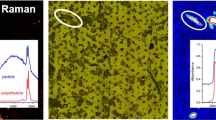Abstract
The effect of powerful nanosecond electromagnetic impulses (PEMI) on the surface and flotation properties of arsenopyrite and carbonate gold-bearing pyrite from the Darasunsk deposit has been studied. X-ray-phase diffractometry, X-ray photoelectronic and IR Fourier-spectroscopy, and raster electronic microscopy were employed in investigations. It was established that the alteration of the phase composition of surface depends non-linearly on terms of treatment (dry or wet) and the number of electromagnetic impulses used and has appreciable influence on oxidation and hydrophobicity of minerals, thus allowing the selective separation of pyrite from arsenopyrite by flotation in the neutral medium.
Similar content being viewed by others
References
V. A. Chanturiya, “The current problems of mineral processing in Russia,” Gorn. Zh., No. 12 (2005).
K. E. Haque, “Microwave energy for mineral treatment processes — a brief review,“ Int. J. Miner. Process. No. 57 (1999).
V. A. Chanturiya, I. Zh. Bunin, V. D. Lunin, Yu. V. Gulyaev, N. S. Bunina, V. A. Vdovin, P. S. Voronov, A. V. Korzhenevskii, and V. A. Cherepenin, “Use of high-power electromagnetic pulses in processes of disintegration and opening of rebellious gold-containing raw material,” Journal of Mining Science, No. 37 (2001).
V. A. Chanturiya, K. N. Trubetskoi, S. D. Viktorov, I. Zh. Bunin, Nano-particles in Processes for Destructure and Exposureof Geomaterials [in Russian], IPKON RAN, Moscow (2006).
V. C. Farmer, The Infrared Spectra of Minerals, Mineralogical society, London (1974).
V. A. Chanturiya, I. Zh. Bunin, and A. T. Kovalev, “On the field emission properties of the sulfide minerals under high-power nanosecond pulses,” Bulletin of the Russian Academy of Sciences, Physics, 71, No. 5 (2007).
Ph. Donato, C. Mustin, R. Benoit, and R. Erre, “Spatial distribution of iron and sulfur species on the surface of pyrite,” Applied Surface Science, No. 68 (1993).
J. P. Baltrus and J. R. Dielh, “An investigation of the weathering behaviour of coal-derived pyrite surfaces by X-ray photoelectron spectroscopy,” Fuel, 73, No. 2 (1994).
P. Forest Walker, Madeline E. Schreiber, and J. Donald Rimstidt, “Kinetics of arsenopyrite oxidative dissolution by oxygen,“ Geochimica et cosmochimica Acta, 70, issue 7 (2006).
A. K. Pikaev, Modern Radiation Chemistry. Radiolysis of Gases and Liquids [in Russian], Nauka, Moscow (1986).
V. L. Bugaenko and V. M. Byakov, Qualitative Model of Radiolysis of Liquid Water and Diluted Solutions of H 2 , O 2 , H 2 O 2 . Influence of Radiation Character and Medium pH on Radoilysis under Action of γ-Rays and Fast-Moving Electrons, Preprint, Moscow (1991).
A. R. Anderson and E. R. Hart, “Radiation chemistry of water with pulsed high intensity electron beams,” J. Phys. Chem., 66, No. 1 (1962).
S. Ya. Pshezhetsky, Radiation and Chemistry [in Russian], Energoatomizdat, Msocow (1983).
V. V. Krymsky and E. V. Litvinova, Properties of Substances under Radiation by Electromagnetic Impulses [in Russian], Izd. ChTGu, Chita (1997).
Hu Guilin, Kim Dam-Johansen, Wedel Stig, and Hansen Peter Jens, “Decomposition and oxidation of pyrite,” Progress in Energy and Combustion Science, No. 3 (2006).
Handbook of Chemistry and Physics. CRS Press (R. C. West Ed.)
L. Tournorten, F. Berger, C. Mavon and A. Chambaudet, “Calcium sulphate formation during the heat-up period: some essential parameters,” Applied Clay Science, 14, Issue 5–6 (1999).
Scaufub G. Andrea, Nesbitt Wayne H., Kartio Ilkka, Laajalehto Kari, Bancroft G. Michael, and Szargan Rudiger, “Incipient oxidation of fractured surfaces in air,” J. Electron Spectroscopy and Related Phenomena, No. 96 (1998).
Q. Zhang, Z. Xu, V. Bozkurt, and J. A. Finch, “Pyrite flotation in presence of metal ions and sphalerite,” Int. J. Miner. Processing, No. 52 (1997).
Author information
Authors and Affiliations
Additional information
__________
Translated from Fiziko-Tekhnicheskie ProblemyRazrabotki Poleznykh Iskopaemykh, No. 5, pp. 105–118, September–October, 2008.
Rights and permissions
About this article
Cite this article
Chanturia, V.A., Filippova, I.V., Filippov, L.O. et al. Effect of powerful nanosecond electromagnetic impulses on surface and flotation properties of carbonate-bearing pyrite and arsenopyrite. J Min Sci 44, 518–530 (2008). https://doi.org/10.1007/s10913-008-0058-2
Received:
Published:
Issue Date:
DOI: https://doi.org/10.1007/s10913-008-0058-2




